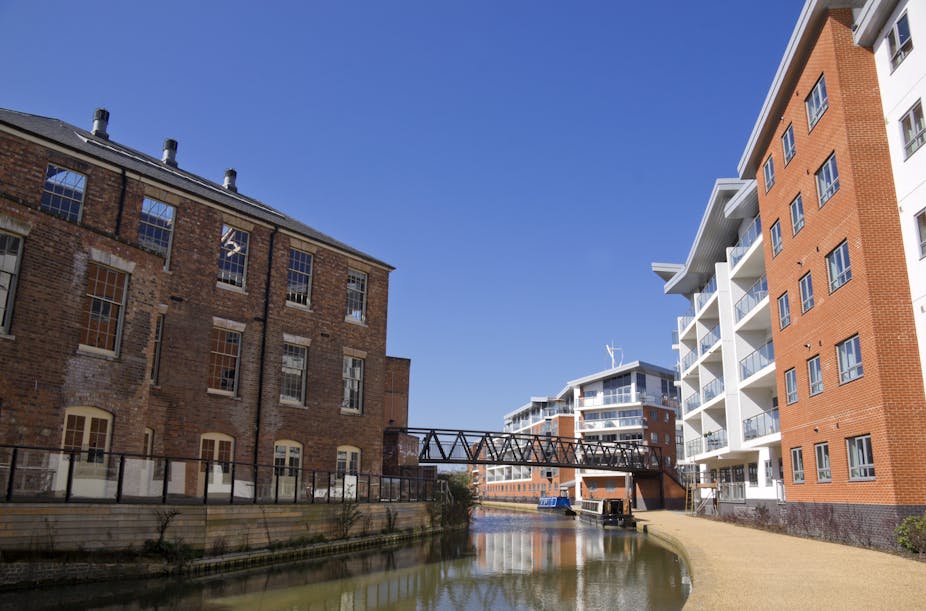The construction of new buildings in the UK emits 48 megatonnes of carbon dioxide (CO₂) each year – that’s equal to the net emissions of the entire country of Scotland. The materials, transportation and construction processes for new buildings are all carbon intensive. For example, cement accounts for an estimated 8% of global CO₂ emissions.
Existing buildings already embody significant CO₂ emissions, which makes it all the more important to upgrade and refurbish – rather than demolish and rebuild – wherever possible. But as it stands, the UK’s tax system actually puts a significant financial penalty on refurbishment, while incentivising new construction.
There are three VAT rates for residential construction: 20% for refurbishment, 0% for most new houses or flats and 5% for certain work, such as redeveloping long-term empty residences or merging two properties into one.
This difference in cost distorts the market significantly towards investment in new buildings, regardless of environmental considerations. Although the rates vary across Europe, my own research has found that similar disparities arise.
Because of this, reforming construction VAT rates would offer an easy opportunity to enormously reduce CO₂ emissions, avoid waste and encourage improvements within the existing building stock – all of which could be done quite simply. With a short transition period to allow continuity for developments that have already received financing or planning approval, such reform could be implemented rapidly, providing a powerful tool to help accelerate sustainable, low-carbon construction.
Make it simple
To start with, construction VAT rates for all dwellings should be simplified: all new or existing building works should have the same 5% rate, as experts have long called for. This would help level the playing field and accelerate energy-saving improvements to existing dwellings and reduce waste, in cases where demolishing an existing building is evidently less environmentally sustainable than refurbishing it.
But this alone won’t go far enough. Although building regulations enforce minimum standards of energy efficiency, there’s currently a lack of incentive and many barriers that prevent developers from delivering lower emissions during construction and better energy performance over the building’s life expectancy, by using advanced sustainable construction techniques and materials.
For example, key feature of the 2019 Stirling Prize winner Goldsmith Street social housing – by Mikhail Riches architects for Norwich City Council – was that it met the widely-recognised Passivhaus standard. This standard calls for a design that reduces heat loss from the building, so much so that it hardly requires any heating at all. Rigorous design, quality control, supervision and testing were required to ensure the reduction of CO₂ emissions massively surpassed building regulations.
Create incentives
In my research, I propose that the existing 0% VAT rate for new dwellings could be redefined, so that developers can only obtain financial rewards if they use low-carbon construction techniques to create highly energy efficient buildings.
This could accelerate reductions in CO₂ emissions and help the UK meet its climate obligations, such as the Paris Agreement. Any cost to the government could be matched by additional income from raising VAT from 0% to 5% on some new buildings, reducing in VAT avoidance (the current 20% rate drives the black economy) and creating long-term economic benefits by reducing demands on energy supply and materials consumption.
Industry standard measures – such as Passivhaus and BREEAM – already provide a way to verify and certify the quality of building construction. Measures that enable the reuse of construction waste should also be taken into consideration.
For example, bricks laid with cement mortar can’t be reused, whereas using lime mortar means they can be recycled whole. This might also include the use of recycled masonry, ironmongery, doors and linings, floors, fittings and windows – all of which used to be available in architectural salvage yards.
So, new or refurbished dwellings that exceed the building regulation requirements by delivering further CO₂ emissions reductions, would receive a 0% VAT rate after being completed and certified according to industry standards. For developers, the recoverable sum would be an incentive driving CO₂ reductions, innovation and higher quality construction.
The realities of the climate emergency are widely recognised across the construction industry, and the prospect of VAT reform already enjoys wide support from bodies including the Architects’ Climate Action Network, RIBA, Historic Environment Scotland, the Town and Country Planning Association, the Society for the Protection of Ancient Buildings and the UK Green Building Council.
Reforming construction VAT so that all projects face the same 5% rate could rapidly incentivise change to more sustainable, low-carbon construction – at no cost to the taxpayer. With the UK seeking to become net carbon neutral by 2050, waiting is no longer an option.

